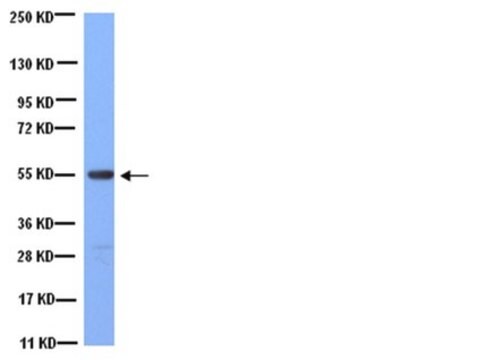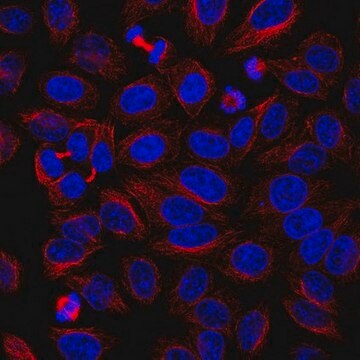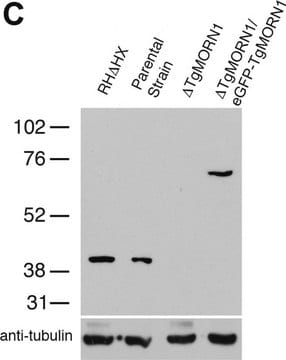추천 제품
생물학적 소스
mouse
Quality Level
항체 형태
purified from hybridoma cell culture
항체 생산 유형
primary antibodies
클론
TUB-1A2, monoclonal
양식
buffered aqueous solution
분자량
~55 kDa
종 반응성
Xenopus, Arabidopsis sp., yeast, insect, rat, hamster, porcine, monkey, bovine, human, mouse, canine, chicken
농도
~1 mg/mL
기술
immunoblotting: suitable
immunofluorescence: 2-4 μg/mL using human HeLa or Chicken fibroblast cells
immunohistochemistry: suitable
동형
IgG3
UniProt 수납 번호
배송 상태
dry ice
저장 온도
−20°C
타겟 번역 후 변형
unmodified
유전자 정보
human ... TUBA1A(7846)
일반 설명
Anti-Tubulin, Tyrosine antibody, Mouse monoclonal (mouse IgG3 isotype) is derived from the TUB-1A2 hybridoma, produced by the fusion of mouse myeloma cells and splenocytes from mouse. Tubulin is an intracellular cylindrical filamentous structure and is presented in eukaryotic cells. It consists of three isoforms α-, β- and γ-tubulin. Tubulin is a heterodimer of α- and β- tubulin subunits.
특이성
Anti-Tubulin, Tyrosine antibody, Mouse monoclonal specifically recognizes the C-terminal Tyrosine of Tubulin protein. The antibody is non-reactive with cells that have been treated with pancreatic carboxypeptidase A under conditions which remove only the C-terminal tyrosine. Monoclonal Anti-Tubulin, Tyrosine recognizes Tubulin from human, mouse, chicken, bovine, rat, hamster, canine, monkey, porcine, arabidopsis, tobacco, yeast, Xenopus, insect, comb jelly, sponge, and worm origin.
면역원
a synthetic peptide containing the carboxy terminal amino acids of porcine a-tubulin
애플리케이션
Anti-Tubulin, Tyrosine antibody, mouse monoclonal may be used in:
- immunoblotting
- immunofluorescence
- immunohistochemistry
생화학적/생리학적 작용
Tubulin is the major building block of microtubules which is essential for structural and mobility elements in mitosis, intracellular transport, flagellar movement and in the cytoskeleton. It is also involved in the nervous system. Tubulin is associated with neurodegenerative disorders such as Alzheimer′s and Parkinson′s disease. Mutations in the αβ- dimers and γ-tubulin are associated with malformation and impairment of cognitive disorders.
물리적 형태
Solution in 0.01 M phosphate buffered saline, pH 7.4, containing 15 mM sodium azide.
저장 및 안정성
For continuous use, store at 2–8 °C for up to one month. For extended storage, freeze in working aliquots. Repeated freezing and thawing is not recommended. If slight turbidity occurs upon prolonged storage, clarify the solution by centrifugation before use. Working dilution samples should be discarded if not used within 12 hours.
면책조항
Unless otherwise stated in our catalog, our products are intended for research use only and are not to be used for any other purpose, which includes but is not limited to, unauthorized commercial uses, in vitro diagnostic uses, ex vivo or in vivo therapeutic uses or any type of consumption or application to humans or animals.
적합한 제품을 찾을 수 없으신가요?
당사의 제품 선택기 도구.을(를) 시도해 보세요.
Storage Class Code
12 - Non Combustible Liquids
WGK
WGK 1
Flash Point (°F)
Not applicable
Flash Point (°C)
Not applicable
가장 최신 버전 중 하나를 선택하세요:
D Boucher et al.
Biochemistry, 33(41), 12471-12477 (1994-10-18)
The multiple functions of microtubules are mediated by various structural and motor microtubule-associated proteins (MAPs). To harmonize these functions in different places of a single cell, the key problem is to regulate the interactions of these proteins with microtubules. The
Soumyananda Chakraborti et al.
Cytoskeleton (Hoboken, N.J.), 73(10), 521-550 (2016-10-19)
Across different cell types and tissues, microtubules are assembled from highly conserved dimers of α- and β-tubulin. Despite their highly similar structures, microtubules have functional heterogeneity, generated either by the expression of different tubulin genes, encoding distinct isotypes, or by
Jennetta W Hammond et al.
Current opinion in cell biology, 20(1), 71-76 (2008-01-30)
All microtubules are built from a basic alpha/beta-tubulin building block, yet subpopulations of microtubules can be differentially marked by a number of post-translational modifications. These modifications, conserved throughout evolution, are thought to act individually or in combination to control specific
T H MacRae
European journal of biochemistry, 244(2), 265-278 (1997-03-01)
This review describes the enzymes responsible for the post-translational modifications of tubulin, including detyrosination/tyrosination, acetylation/deacetylation, phosphorylation, polyglutamylation, polyglycylation and the generation of non-tyrosinatable alpha-tubulin. Tubulin tyrosine-ligase, which reattaches tyrosine to detyrosinated tubulin, has been extensively characterized and its gene sequenced.
Tubulin: Structure, Functions and Roles in Disease
Binarova P and Tuszynski J
Cells, 10(3), 194-204 (2019)
자사의 과학자팀은 생명 과학, 재료 과학, 화학 합성, 크로마토그래피, 분석 및 기타 많은 영역을 포함한 모든 과학 분야에 경험이 있습니다..
고객지원팀으로 연락바랍니다.








